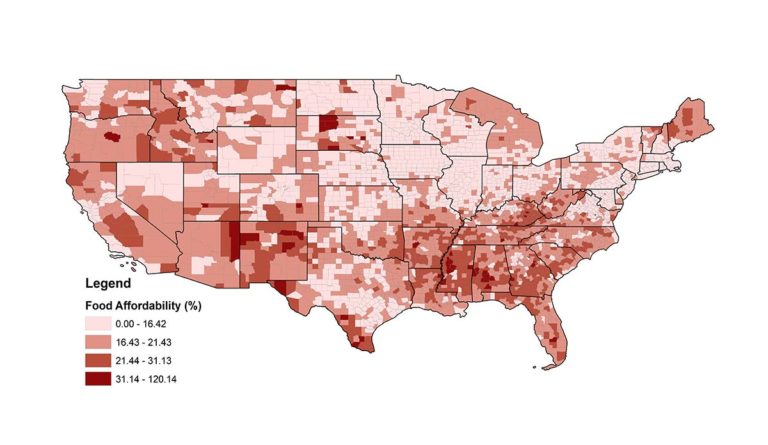National Food Affordability: A County-Level Analysis
Food insecurity across the US is in relative decline, but pockets of particularly vulnerable Americans remain very food insecure.

Read Time: 3 minutes
Published:
Food insecurity is an important economic and policy issue, both globally and in the United States. Food insecurity reduces individual performance, limits cognitive development, and increases risk for developing nutrition-related chronic diseases such as hypertension, obesity, and type II diabetes. While food insecurity across the US is in relative decline, pockets of particularly vulnerable Americans remain very food insecure. Residents in the US South and Appalachian regions continue to struggle with food security in particular.
These persistent pockets of food insecurity are a result of larger structural issues such as unemployment, pay inequity, inter-generational poverty, and poor food environment. Additionally, many of the social safety-nets these communities must use, such as social security and disability payments, place them on a fixed income, well below the federal poverty level, making it hard to manage household expenses and food purchases.
Food environment plays a monumental role in creating and perpetuating food insecurity. Food environment includes the types of and distance to stores, restaurants, or other venues available to purchase or access food. Food environment also includes the quality of foods available. The nature of food environment dictates how affordable food is for households, especially nutritionally-dense foods such as vegetables. While food affordability is measured in many ways, this measure examines the money households spend as a percentage of household income.
Nationally, Americans spend roughly 10% of their income on food, spread evenly across food prepared at home and food eaten outside of the home. However, our recent study suggests this may not be the case. We used data from grocery store scans and estimated a percentage of household income spent on food for all 3,142 counties in the US. On average, using this model of food affordability, households spent 18% of their income on food nationally.
Average expenditures on food were nearly double the USDA-predicted 10%. And rural households spent a significantly larger portion of their income on food, compared to urban counties.
Average expenditures on food were nearly double the USDA-predicted 10%. And rural households spent a significantly larger portion of their income on food (18.84%), compared to urban counties (16.86%). This difference is due, in large part, to the lower incomes of rural households and higher rates of poverty. Rural communities also tend to have higher food prices due to inaccessibility and lack of competition between retailers. The remoteness of rural retailers means these stores pay higher shipping and transportation costs and have lower product turnover. Two rural regions had notably lower food affordability when compared to all other counties: the Delta and Appalachia.

This analysis shows us that rural areas suffer disproportionately from poor food environments and are much more likely to have unaffordable food. There are many ways to address this inequity. Local grocery cooperatives, community-based food projects, rural development programs that focus on building social interconnectedness, and advocacy to influence state and regional planning or policy.
Maps courtesy of the authors.






